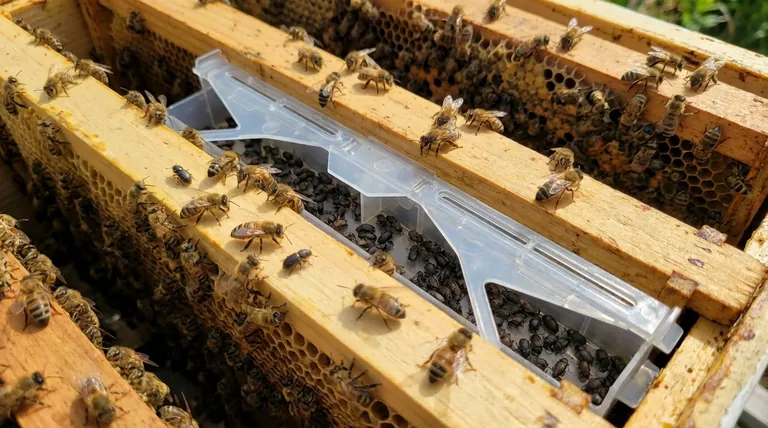Yes, it is normal to see a few small hive beetles in a modern beehive. The presence of a handful of these pests is not an immediate cause for alarm, much like spotting a single cockroach in a house. The critical distinction is between the mere presence of a few adult beetles, which a strong colony can manage, and a full-blown infestation where their larvae have taken over.
The core issue is not the existence of a few beetles, but the uncontrolled reproduction that leads to an infestation. A healthy, populous colony can police a small number of beetles, but a weak colony is quickly overwhelmed, leading to hive failure.

The Difference Between Presence and Infestation
Understanding what to look for is the key to protecting your colony. The signs of a manageable presence are vastly different from the signs of a destructive infestation.
The Normal "Scout" Beetle
It is common to see a few adult beetles scurrying away from the light when you open a hive. These are opportunistic pests seeking food and a place to reproduce. A strong, healthy colony has "guard" bees that will actively manage these intruders.
A Healthy Colony's Defense
You may observe bees chasing beetles or successfully imprisoning them in a "jail" of propolis, often in the corners of the hive. This is a positive sign that your colony is strong enough to police the pest population on its own.
When Presence Becomes a Problem
The danger escalates when the beetles are able to successfully reproduce. The adult beetles themselves do minimal damage; their larvae are responsible for the destruction. A beetle can lay thousands of eggs, and a weak or stressed colony cannot remove them fast enough.
The Telltale Signs of Infestation
An infestation is unmistakable and requires immediate action. The signs are stark:
- Large numbers of beetles: Dozens or hundreds of beetles are visible on the frames.
- Slimy larvae: You will see masses of small, maggot-like worms crawling over the comb.
- Hive slime: As the larvae tunnel through comb, they defecate and cause the honey to ferment, creating a slimy, glistening mess.
- Foul smell: The fermenting honey and beetle waste create a distinct and awful odor, often compared to that of rotting oranges.
Understanding the Risks of an Unchecked Population
Ignoring the warning signs allows the beetle population to spiral out of control, leading to the complete loss of the hive.
How Beetles Overwhelm a Colony
The beetle larvae destroy everything they touch. They consume pollen, honey, and bee brood, contaminating the hive with slime. This contamination ruins the honey and can starve the colony.
The Final Outcome: Absconding
Faced with a completely fouled and unsanitary environment, the bees' only remaining option is to abandon the hive. This is called absconding. The queen and the remaining bees will flee, leaving behind a ruined mess of slime, larvae, and dead brood.
Making the Right Choice for Your Hive
Your response should always be proportional to the threat level you observe in your hive.
- If you see a few adult beetles and the colony is strong: Your primary focus should be on hive management and considering simple, non-invasive traps as a preventative measure.
- If you see beetle larvae, slime, or a foul smell: You are dealing with an active infestation that requires immediate intervention, which may include reducing hive space, installing more aggressive traps, or even requeening to boost colony strength.
Ultimately, maintaining a strong, populous, and healthy colony is your most powerful defense against the small hive beetle.
Summary Table:
| Situation | Signs | Action Required |
|---|---|---|
| Normal Presence | A few adult beetles scurrying; bees chasing them. | Monitor hive strength; consider preventative traps. |
| Active Infestation | Beetle larvae, hive slime, foul odor, bees absconding. | Immediate intervention required. |
Protect Your Commercial Apiary with Professional-Grade Equipment
Don't let small hive beetles threaten your operation. A strong hive is your best defense, and that starts with robust, reliable equipment. HONESTBEE supplies commercial apiaries and beekeeping equipment distributors with the high-quality, wholesale-focused supplies needed to maintain healthy, productive colonies.
Contact our team today to discuss your wholesale needs and ensure your hives are equipped to handle pests.
Visual Guide

Related Products
- Reusable Clear Small Hive Beetle Traps for Beehives Beetle Trapping Tools
- Black Plastic Beetle Barn Hive Beetle Trap for Beehives
- Removable Washable Hive Beetle Trap Attractants for Small Hive Beetles
- Plastic Beetle Blaster Trap Beekeeping Tools and Supplies
- Gourd Shaped Hanging Wasp Trap Professional Wasp Catcher
People Also Ask
- What are the advantages of handheld beetle blasters and traps? Simple, Chemical-Free Hive Protection
- How should filled beetle traps be handled? Safely Remove and Dispose to Protect Your Hive
- What is the best time to use beetle traps? Master the Spring Strategy for Effective Hive Protection
- What is the recommended number of beetle traps per hive? Optimize Your Hive's Beetle Defense
- Why are hive beetle traps important for beekeepers? Protect Your Hive from a Devastating Infestation



















